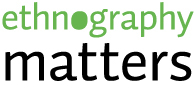 Editor’s note: In this thoughtful piece for February’s Openness Edition, Sarah Kendzior (@sarahkendzior) discusses the ways in which the internet has transformed the relationship between the writer and the people about whom he or she writes. Sarah has written extensively about open access to scholarly publications (‘one paper (she) uploaded to Academia.edu… helped Uzbek refugees find a safe haven abroad’, according to one interview). In this post, Sarah writes about a deeper question regarding the openness of the research process and the ways in which the internet has led to a leveling of the playing fields in a way that some anthropologists would rather ignore than confront. After all, when the “subaltern speaks” and anyone, not just anthropologists, can hear, who exactly is doing the exposing?
Editor’s note: In this thoughtful piece for February’s Openness Edition, Sarah Kendzior (@sarahkendzior) discusses the ways in which the internet has transformed the relationship between the writer and the people about whom he or she writes. Sarah has written extensively about open access to scholarly publications (‘one paper (she) uploaded to Academia.edu… helped Uzbek refugees find a safe haven abroad’, according to one interview). In this post, Sarah writes about a deeper question regarding the openness of the research process and the ways in which the internet has led to a leveling of the playing fields in a way that some anthropologists would rather ignore than confront. After all, when the “subaltern speaks” and anyone, not just anthropologists, can hear, who exactly is doing the exposing?
Sarah Kendzior is an anthropologist and communications scholar who studies digital media and politics. Her home blog is at sarahkendzior.com.
Check out past posts from guest bloggers.
________________________________________________________________________
In the hallway of my anthropology department there was a map of the world. The map was covered with photos of students in the field, their exact location pinpointed by an image on a string. Every year, the academic coordinator would send out a call to students for a representative photo to add to the map, and every year, I failed to respond.
During the bulk of my dissertation fieldwork, I lived in Missouri. The people I wrote about, Uzbek exiled political dissidents, lived all around the world — in Sweden, Russia, Kyrgyzstan, Canada, the United States, Turkey. Having fled a brutal crackdown following a massacre of civilians, they lived lives of constant upheaval, on the move and on the run. They thought less about where they were than they did about Uzbekistan, the one place they could not go. They spent most of their time online, talking to each other and talking to me. I could not go to Uzbekistan either, since my previous articles criticized its authoritarian regime.

This picture shows the inside of the truck of the leader of the Birdamlik People’s Movement, an Uzbek opposition group. Birdamlik has branches in over a dozen countries (including Uzbekistan) but they are organized through the internet. The leader of the movement works in the US as a truck driver, and he calls this his “mobile office” — a communications center set up inside his 18-wheeler. The computer screen shows the Birdamlik website, which is banned in Uzbekistan. Pic by Sarah Kendzior (all rights reserved)
The online communities of exiled dissidents made for an interesting dissertation. But it posed a problem when it came to the department map. Should I mark every point on the map or none of them? Should I designate Uzbekistan somehow – a skull and crossbones, a circle with a slash? What was my “representative image” – an activist curled up with his laptop, updating his Facebook status? A blogger staring at Cyrillic on a screen? Me, alone at my desk, checking my email?
No one wants to see these things. No one wants to see visual documentation of their own online lives, much less the lives of others. It is the academic version of the tabloid reveal – “Uzbek dissidents – they’re just like us!” Such banality runs counter to anthropological advertising. The purpose of the department map was to show visitors that our research subjects are not just like us – but that we, for a time, could be just like them.
I was like the people I studied too, in that none of us have a place within the traditional conception of anthropological fieldwork. We were too much on the move, or we were not moving enough. Read More…


 Editor’s note: In this final post for February’s ‘
Editor’s note: In this final post for February’s ‘











Recent Comments